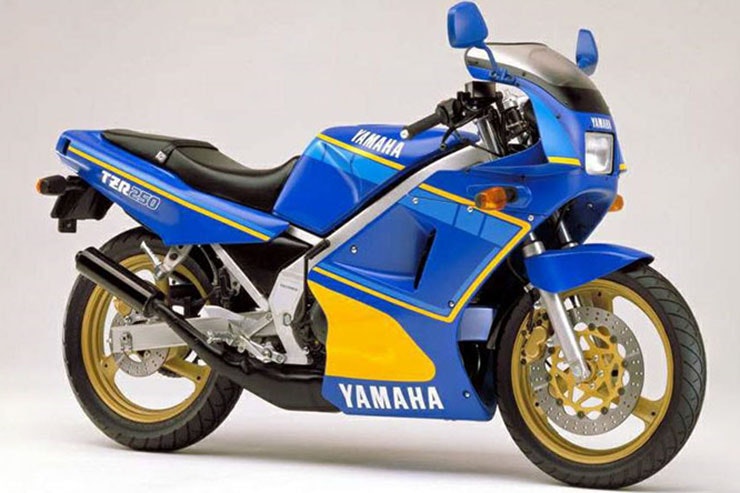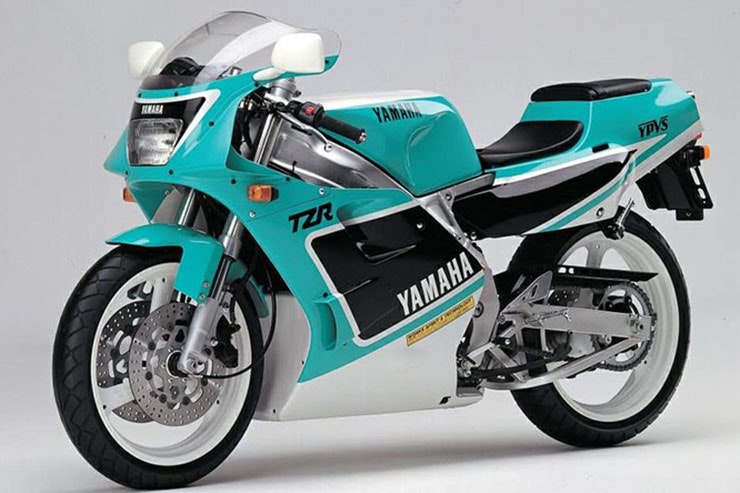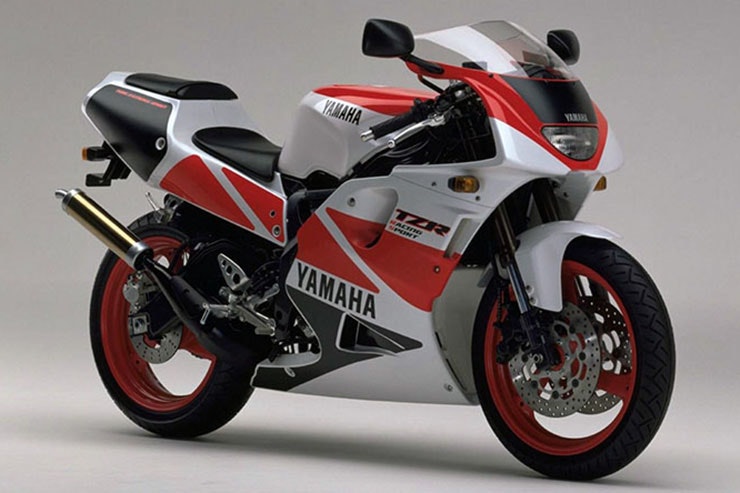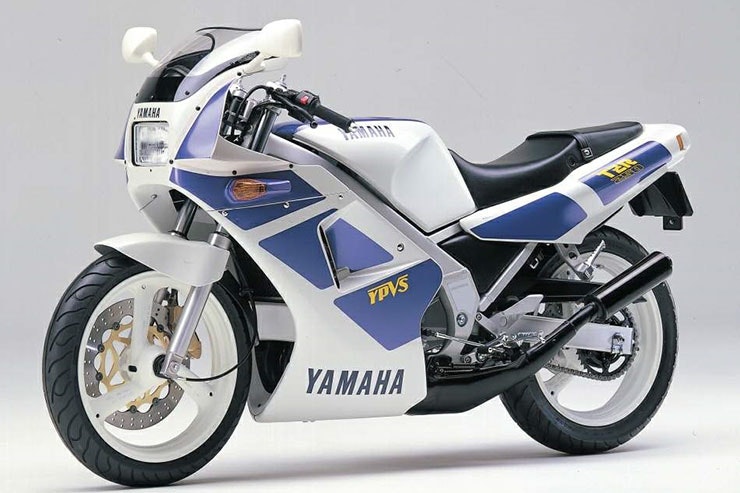Yamaha TZR250 (1986-1995) - Review & Buying Guide
By Jim Moore
Bike journo for a quarter of a century
14.05.2024
£3,000-£15,000
50bhp
128kg
4/5
Yamaha’s TZR250 was the RD-LC for the late ’80s and ’90s. Light, powerful, and capable of running rings around much larger and more powerful machinery, the TZR was a huge success in Japan and around the world. Europe (the UK especially), Australia, New Zealand, and Canada were all strong markets for the original 2MA model.
Suzuki’s gorgeous RGV250 and Kawasaki’s bonkers-fast KR-1/1S ran the TZR hard in the UK, but the Yamaha proved more reliable against often fragile opposition, despite its obvious likeness to TZ250 race machines of the era. For many of us now well into middle age, the TZR250 is a nostalgic reflection of fun-drenched, care-free times. That’s why it’s such a popular modern classic.
Yamaha UK opted not to import the even funkier, achingly gorgeous reverse-cylinder 3MA and later V-twin 3XV TZRs to these shores, but that didn’t stop myriad grey importers from bringing them here in reasonable numbers throughout the 1990s. RGVs were omnipresent on every High Street throughout that time, but the more exotic second and third generation TZRs were always that bit more desirable. And still are.
Contemporary 250s aren’t even close to matching TZRs in terms of performance, technology, desirability, or build quality, despite the 30 year age gap. What’s more, there’s a TZR to suit most pockets, with tidy 2MAs starting at around £3000. Even the ultra-rare and exotic 3XV SPR model (less than 500 were built) are easier on the pocket than Honda’s equivalent NSR250R SP MC28 by several thousand quid. Here’s why they rock.
Intense two-stroke fun; early models are easy to maintain too
Will only go up in value, so a sound investment
Amazing handling, despite being more than three decades old
Getting expensive – late, low mileage 3XV SPRs can make £15K-plus
Require regular maintenance if they’re to stay reliable – especially 3MAs
Spares are getting thinner on the ground
Yamaha TZR250 (1986-1995) Price
There are three distinct TZR250 models. The original, known as the 2MA in the UK, and 1KT/2XT in Japan, sold in the home market from 1986-1988, and the UK from 1987-1991. Second generation TZRs, known as 3MA, were Japan-only and completely different from the previous model, sporting reverse-mounted cylinders and under seat pipes. They were sold in 1989 and 1990. The final incarnation, the 3XV, was also Japan only. Introduced in 1991, and sold through to 1995, the 3XV differs from both previous models with its V-twin engine, tighter chassis, fatter tyres and numerous track-ready SP, RS, and SPR variants.
TZR250 1KT/2MA/2XT values: Rough £1500-£2500; Tidy £3000-£4300; Mint £4500-£5000
Original TZR250, launched first in Japan in 1986 as the 1KT model with faired-in front and rear indicators, a white tacho and 45bhp motor. UK models (2MA) arrived in 1987 in full power spec (claimed 50bhp), with indicators on stalks, and larger mirrors; the equivalent in Japan for 1987 was coded as the 2AW (which included a Marlboro rep). Colour changes only throughout UK run. 1988 Japanese bike, 2XT, got Nikasil bores, extra inlet ports, a wider reed cage and inlet, plus a slightly wider rear wheel. 45/50bhp, 128kg.
Colours: red/white, Gauloises blue, blue/white, black/yellow, black/yellow, Marlboro rep
TZR250 3MA values: Rough £3500-£4800; Tidy £6000-£8500; Mint £9500-£10,500
Completely new model with reverse mounted barrels (carbs and airbox at the front with straight exiting underseat pipes – as per the TZ250 racer of the time). Underbraced swingarm, dual front discs, wider wheels and tyres. 1990 model heavily revised, to address issues with reliability and inconsistent fuelling; usd forks, new swingarm, jetting and ignition settings. 1990 bike also available as an SP, with dry clutch, close-ratio gearbox, and fully adjustable suspension. Japan market/grey import only. 45bhp, 128kg. Colours: red/white, black/red/white, turquoise/black/white, black/silver
TZR250 3XV values: Rough £4000-£5500; Tidy £7000-£9000; Mint £10,500-£15,000*
Final TZR model and again a complete redesign with an all new V-twin engine, plus GP inspired chassis and styling. Several models available throughout a four year run, from basic R model to SP, RS, and extremely rare SPR spec (1995 only). Japanese market/grey import only. 40/45bhp, 126kg. Colours: red/white, black/graphite, white/graphite, white/red/black,
*top prices for 3XV are for rare SP/SPR models
Yamaha TZR250 (1986-1995) Engine and Performance
When the TZR250 first appeared on UK shores in 1987 its claimed output of 50.3bhp at 10,000rpm made it the most powerful quarter-litre production bike ever. Yamaha’s power figure was measured at the crank, however, rather than the rear wheel, so the horsepower reaching the road was nearer 44. Nonetheless, the TZR’s performance was mightily impressive for such a small engine.
The engine leaned heavily on technology already employed in Yamaha’s TZ250 racer. Bore and stroke (56.4 x 50mm) was almost identical to that of the TZ (56 x 50.7mm) and unlike Yamaha’s previous 250cc road two-strokes the TZR featured mixture induction directly into the crankcases via 28mm flatslide carbs. A development of Yamaha’s pioneering YPVS powervalve system altered exhaust port height to suit rpm, providing a strong bottom end and midrange performance without sacrificing top end. Top speed was anywhere between 115-119mph, depending on conditions.
The only significant development to the first generation engine came in 1988 to the home market 2XT. New crankcases, featuring a larger intake and reed cage, enlarging the inlet tract by 25% compared to the 1KT, boosted midrange performance, as did extra inlet ports. Nikasil coating was added to the bores, too.
For 1989 Yamaha created a completely new TZR, the 3MA, which featured reversed barrels for a straighter exhaust exit – just like the TZ250. Bore x stroke remained the same, but few other components are interchangeable between the 3MA and earlier models. Although stunning to behold and dripping in tech, the 3MA proved too complicated and rushed to production for its own good.
Inconsistent fuelling – often running far too lean – saddled the 3MA with a reputation for fragility and temperamental running. An extensive overhaul of the jetting, ignition timing and internals for 1990 cured many of the 3MA’s ills, but by that point the damage to its name was done. The SP, with its dry clutch, close-ratio box, different pipes and CDI is the one to have.
1990 saw wholesale change once again, with the introduction of the 90° V-twin 3XV. Again based on firm’s TZ250 racer (rather than John Kocinski’s GP title winning YZR250). Bore and stroke matched the TZ’s 56 x 50.7mm, and much of the TZR engine’s architecture mirrored that of the production racer – the SP model’s crank is per TZ spec, and the TT-F3 kit’s pipes, barrels, pistons etc are all almost identical to the TZ.
Performance of the 3MA and 3XV was restricted to 45bhp and 180kph by Japanese law, although bypassing the speed restriction is easy with a MPH converter on the speedo. Unleashing more power is harder, requiring pipes, a CDI and up-jet (70bhp is possible with the factory TT-F3 kit, although these are now rare and expensive), but in stock form the engines are remarkable tractable for two-strokes of their size.
Yamaha TZR250 (1986-1995) Handling & Suspension
Minus bodywork, the 2MA looks every inch a TZ250, from its aluminium Deltabox frame and hollow three-spoke wheels, to its massive 320mm front disc and Brembo style Sumitomo caliper (half the braking set-up of an FZR1000). With a dry weight of just 128kg, the TZR is crisp and responsive; the only let down being a basic shock and forks.
Fitted with better quality suspension and sticky tyres, a 2MA can still be a weapon on track or your favourite country road. Indeed, racing journo Mat Oxley lapped the Isle of Man TT course on a first gen TZR at an average of 100mph – a first for a proddie 250. 2XT models have the best first gen chassis, featuring a revised shock linkage and wider 3.5in rear wheel.
The 3MA’s aluminium Deltabox frame and braced swingarm are works of art (the frame later employed on the SZR660 single and Italy only TZR125R 4DL). 1989 bikes run conventional 41mm forks (preload adj only, as per the shock) and twin 298mm front discs. For 1990, Yamaha updated the swingarm, removing the section between the arm and brace, and fitting upside forks – the SP model has fully adjustable suspension front and rear. To ride, the 3MA feels bigger than the 2MA, and not quite as sharp as Honda’s NSR250R MC18.
As with its engine, the 3XV gained a completely new chassis, again an aluminium beam frame, but with a banana style swingarm, as per the TZ. With 40mm shaved off the wheelbase, compared to the 3MA, the V-twin turns and handles quicker. At 126kg, it’s also a full 10 kilos lighter than the reverse cylinder model. On both road and track the 3XV is still a match for most modern middleweights. And as with the 3MA, an SP 3XV is best, offering higher quality, fully adjustable suspension.
Yamaha TZR250 (1986-1995) What to look for
Pistons/rings: Early 1KT/2MA models were susceptible to top ring pegs coming loose, falling out, and trashing the top end. TDR250 (2YK) pistons are the cure. Cooler running BR10EV plugs in place of the OE BR9ES lessen the chance of pre-ignition melting pistons.
Exhausts: The left side spannie (first gen TZRs) can crack near the exhaust port. Check any potential purchase for signs of potential failure.
Powervalves: Reliability of first gen TZRs is good – it’s a strong motor – but the YPVS system can chew its locating bushes and, if left unchecked, will collapse in on itself resulting in an expensive top end rebuild. The valves on all TZRs go through a run cycle when the ignition is turned on; you’ll hear a whirr-whirr as they rotate back and forth.
Poor fuelling: An issue with 1989 3MAs. Jetting was lean from the factory, leading to seizures. If you buy or restore an ’89 3MA, get it set up on a dyno to perfect the fuelling. It’s a belt and braces insurance that could save a lot of hassle and expense. Rough low-rpm fuelling can also be a sign that there’s an issue with the throttle position sensor and/or the air bleed solenoids. 1990 bikes are far superior in this regard.
Fuel tanks: Yamaha’s 1980s/90s fuel tanks are made from notoriously thin steel. Rotting through from the inside out is common, so check thoroughly – corrosion can also contaminate fuel, leading to engine failure.
Know your 3XV: A genuine SP 3XV will have 41mm forks (Rs have 39mm), TZ style heads, close-ratio gearbox, dry clutch (RS also has dry clutch), billet chain adjusters, and 3XV10, 20 or 50 markings on the cylinders – RS models have 3XV00, 3XV30 or 3XV50 stamps. Carbs are the other giveaway; R and RS models run 28mm Mikuni roundslide. 1991-1992 SP have 36mm flatslides, 32mm on 1993-1994, and 32mm D-slides in 1995.
Yamaha TZR250 (1986-1995) Rivals
Honda NSR250R - Beautifully engineered GP reps that come in a range of models and specs, from early MC16s to late SP MC28s. May only make 45bhp at most, but all NSRs offer an amazing spread of power. Handling is sublime and all models – MC21 and MC28s especially. Strong rivals for every TZR model, but the Hondas are marginally better in every regard.
Kawasaki KR-1/1S - Razor sharp, peaky and still the fastest production 250s ever build. Ludicrous fun, but high maintenance and not quite as polished as their rivals. Early KR-1s can be unreliable; the later 1S model is better – and faster – but you’ll need to refresh rings every 4000 miles and pistons every 6500 if the engine is to stay in one piece.
Suzuki RGV250 - Gorgeous 2T screamers that look as fabulous today as they did when launched. VJ22 models – especially the 1991 M – are collectors’ favourites. Loads of go-faster goodies and tuning expertise still out there. J-market VJ23 is the most advanced, and a real competitor to the 3XV, but prices are getting strong.
Honda NSR250R, 1987-1996 | Approx Price: : £5000-£20,000
45bhp/26lb-ft
125kg
Kawasaki KR-1/1S, 1988-1993 | Approx Price: £5000-£9000
45bhp/26lb-ft
125kg
Suzuki RGV250, 1988-1999 | Approx Price: £4000-£15,000
55bhp/29lb-ft
128kg
Yamaha TZR250 (1986-1995) Verdict
No matter the model, a well maintained TZR250 is an exciting ride. If you’re looking first gen, go either 2MA (you’ll get full power and UK spec) or a 2XT – the most advanced of the originals. For 3MA, aim 1990; they’re much more sorted than the problematic ’89 model. 3XVs remain some of the sharpest, most rewarding lightweights ever produced. Ignore the 30 year old vintage. The engineering, style and ride still feel contemporary. Buy a good one – projects can be frustrating money pits – and you’ll have a ball.
If you’d like to chat about this article or anything else biking related, join us and thousands of other riders at the Bennetts BikeSocial Facebook page.
Yamaha TZR250 (1986-1995) – Technical Specification
| Original price | £2999 |
| Current price range | £4000-£15,000 |
| Capacity | 249cc |
| Bore x Stroke | 56.4 x 50mm |
| Engine layout | Liquid-cooled, two-stroke parallel-twin with YPVS |
| Power | 50bhp (36.4kW) @ 10,000rpm |
| Torque | 26.2lb-ft (35.4Nm) @ 9750rpm |
| Top speed | 119mph |
| Transmission | 6-speed, wet, multiplate clutch, chain final drive |
| Average fuel consumption | 33mpg |
| Tank size | 16 litres |
| Max range to empty (theoretical) | 116 miles |
| Reserve capacity | n/a |
| Rider aids | none |
| Frame | Aluminium Deltabox beam |
| Front suspension | 39mm telescopic forks |
| Front suspension adjustment | Preload adjustable |
| Rear suspension | Monocross monoshock |
| Rear suspension adjustment | Preload adjustable |
| Front brake | 1 x 320mm discs, 2-pot caliper |
| Rear brake | 210mm disc, 1-pot caliper |
| Front tyre | 100/80 17 |
| Rear tyre | 120/80 17 |
| Rake/Trail | 24°/ 90mm |
| Dimensions (LxWxH) | 2005mm x 660mm x 1075mm |
| Wheelbase | 1375mm |
| Ground clearance | n/a |
| Seat height | 760mm |
| Dry weight | 128kg |



